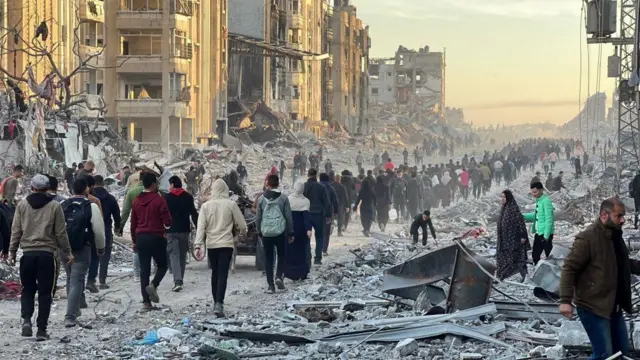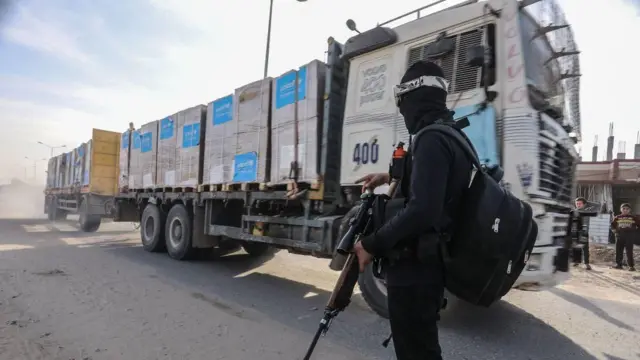
image source, Reuters
- Author, Rushdi Abu Alouf – Andre Roden-Paul
- Role, Gaza correspondent – BBC News
Immediately after the announcement of the ceasefire between Hamas and Israel, Palestinians poured into the streets of Gaza to celebrate this step, but the moments of joy quickly faded for many of them when they returned to their homes to find the extent of the destruction inflicted on them.
In the town of Jabalia, which includes the largest refugee camp north of Gaza, photos and videos shared by residents revealed that entire neighborhoods had turned into rubble.
Upon her return to the Al-Faluja area in Jabalia, Duaa Al-Khalidi told BBC News: “I survived with my daughter from under the rubble of our house.” “But here, under the rubble, the bodies of my husband, my mother-in-law and my sister-in-law are still buried since October 9.”
The 28-year-old mother, who has two children, added: “I want nothing but their bodies so I can bury them with dignity.”
Jabalia camp, which is home to more than 250,000 Palestinians, became the scene of the largest and most violent Israeli military operation during the war, in which about 4,000 Palestinians were killed, according to the Hamas-run Health Ministry.
Hussein Odeh was also among those returning to Jabalia and documented his return journey from Gaza City.
Odeh was a professional weightlifter who represented Palestine internationally, but now he has lost 10 members of his family at the beginning of the war.
He wrote a post in which he said: “The best thing that happened today is that after 100 days, we were able to bury them with dignity.” “In the past few days, I have been able to visit my family’s graves and pray for them.”
Odeh also posted a video clip depicting the extent of the destruction to his three-story house, as well as to the sports club he owns.
He added: “Here I lost the people closest to my heart – my brothers, my children, my source of livelihood. The war killed everything beautiful within us.”

image source, Getty Images
In the city of Khan Yunis, south of the Gaza Strip, Hamas gunmen roamed the streets amid chants and singing, according to Reuters.
Hamas policemen wearing police uniforms were also deployed in some areas, after months of hiding to avoid Israeli strikes.
Ahmed Abu Ayham, a Gaza resident who was taking shelter with his family in Khan Yunis, told Reuters that the situation in his city was “horrific.”
Residents of the city, which suffered the most destruction according to experts, were seen waving the Palestinian flag and filming the scenes on their phones.
But Abu Ayham, 40, said that “it is not a time for celebrations,” despite the fact that a ceasefire “could save lives.”
He added: “We are suffering from pain, deep pain, and it is time for us to hug each other and cry.”
Gazans also rushed to the southern city of Rafah, close to the Egyptian border.
Muhammad Suleiman said to the Gaza Today program broadcast on BBC Arabic: “Praise be to God, we received the news of the entry into force of the ceasefire with joy and happiness.”
He added: “God willing, things will change for the better and we will return to Rafah. I hope that every displaced person will return to their home safely.”
Many displaced people fled Rafah after Israel ordered them to leave before the start of the military operation in the city south of Gaza.
In Rafah, Muhammad al-Jamal, a journalist for the Palestinian newspaper Al-Ayyam, spoke of his personal loss.
He said: “The house was leveled to the ground, and everything turned into rubble. The chicken coop and the fig tree whose fruits we shared together are now a thing of the past.”

image source, Getty Images
The fragility of the ceasefire agreement between Hamas and Israel became apparent from the first hours of its signing.
The agreement finally entered into force after a three-hour delay, during which 19 Palestinians were killed and Israel said it launched strikes on “terrorist targets.”
In the afternoon, three Israeli hostages returned to Israel, as part of the first six-week phase, which will see the release of 33 Israeli hostages.
But people in Gaza still fear that the truce will collapse again.
